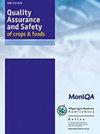从伊朗马卡齐省收集的不同类型水果、土壤和水样中的基本元素:健康风险评估研究
IF 5.3
3区 农林科学
Q1 FOOD SCIENCE & TECHNOLOGY
引用次数: 20
摘要
水果可能含有不同浓度的元素,这些元素对人体健康既有积极的影响,也有消极的影响。采用电感耦合等离子体发射光谱(ICP-OES)技术测定了伊朗马尔卡兹省6个工业区5种水果(桃、苹果、葡萄、油桃、金梅)和土壤、灌溉水中铁(Fe)、铜(Cu)、锌(Zn)、锰(Mn)、铬(Cr)的含量。通过确定目标危害商和蒙特卡罗模拟模型来评估非致癌风险。铁、锰、铬在金梅中含量最高,铜、锌在葡萄和苹果中含量最高。土壤和水样中元素的平均浓度顺序为Fe > Mn > Zn > Cu b> Cr,传递因子(TF)结果表明,所研究的水果不能从土壤中吸收大量的这些元素(TF < 1),成人和儿童这些元素的目标危害商值为Cr > Cur > Fe > Mn > Zn。目标危害商为95%,总目标危害商<1,说明消费者食用水果是安全的。本文章由计算机程序翻译,如有差异,请以英文原文为准。
Essential elements in the different type of fruits, soil and water samples collected from Markazi province, Iran: a health risk assessment study
Fruits could contain elements in various concentrations, which can have both positive and negative impacts on human health. The concentrations of essential elements, including Iron (Fe), Copper (Cu), Zinc (Zn), Manganese (Mn), and Chromium (Cr) in five types of fruits, namely, peach, apple, grape, nectarine, and golden plum, and the soil and irrigation water from six industrial zones of Markazi province, Iran, were evaluated using an inductively coupled plasma-optical emission spectroscopy (ICP-OES) technique. The noncarcinogenic risk was assessed by determining the target hazard quotient and the Monte Carlo simulation model. The highest concentrations of Fe, Mn, and Cr were observed in golden plum, while the highest concentrations of Cu and Zn were noted in grape and apple, respectively. The order of the mean of concentrations of elements in the soil and water samples were Fe > Mn > Zn > Cu > Cr. The transfer factor (TF) results indicate that studied fruits could not absorb a high amount of these elements from the soil (TF < 1). Target hazard quotient values of these elements in both adults and children were ranked as Cr > Cur > Fe > Mn > Zn. The target hazard quotient was 95% and total target hazard quotient was <1, meaning that the consumption of fruits is safe for consumers.
求助全文
通过发布文献求助,成功后即可免费获取论文全文。
去求助
来源期刊

Quality Assurance and Safety of Crops & Foods
FOOD SCIENCE & TECHNOLOGY-
CiteScore
4.60
自引率
7.50%
发文量
61
审稿时长
1 months
期刊介绍:
''Quality Assurance and Safety of Crops & Foods'' is an international peer-reviewed journal publishing research and review papers associated with the quality and safety of food and food sources including cereals, grains, oilseeds, fruits, root crops and animal sources. It targets both primary materials and their conversion to human foods. There is a strong focus on the development and application of new analytical tools and their potential for quality assessment, assurance, control and safety. The scope includes issues of risk assessment, traceability, authenticity, food security and socio-economic impacts. Manuscripts presenting novel data and information that are likely to significantly contribute to scientific knowledge in areas of food quality and safety will be considered.
''Quality Assurance and Safety of Crops & Foods'' provides a forum for all those working in the specialist field of food quality and safety to report on the progress and outcomes of their research.
 求助内容:
求助内容: 应助结果提醒方式:
应助结果提醒方式:


